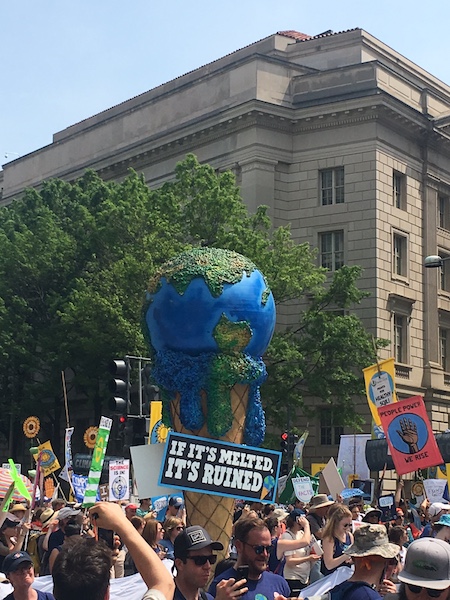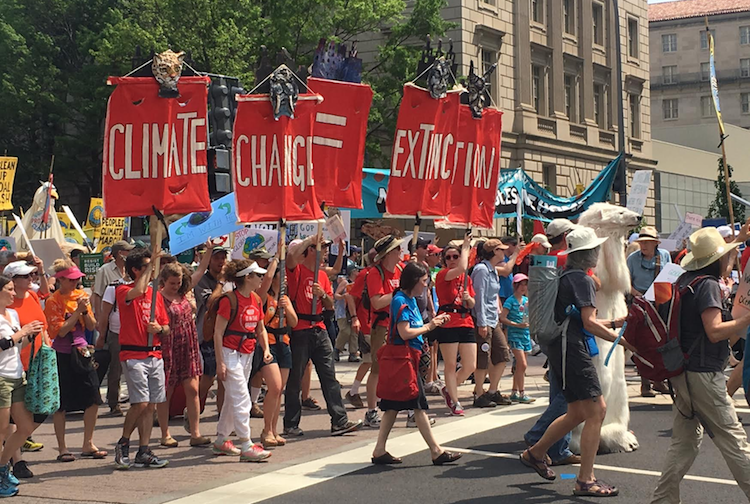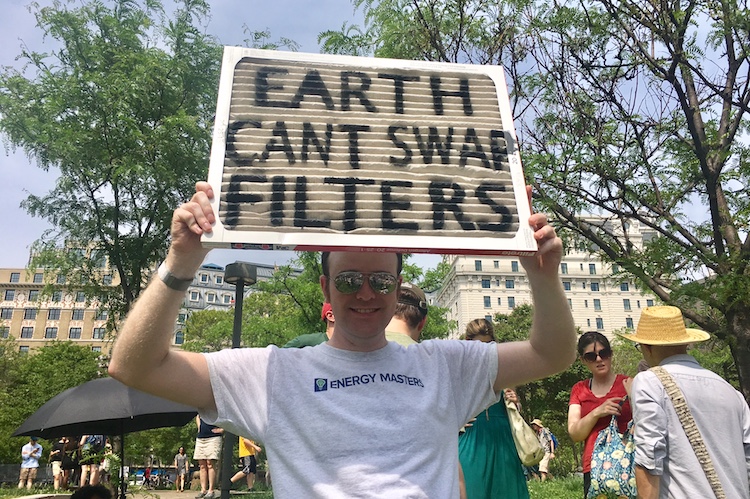| Above: A throng stretched for blocks along Pennsylvania Avenue in Washington, with the U.S. Capitol in the background, during the People's Climate March on April 29, 2017. Image credit: Bob Henson. |
A crowd estimated by organizers to be 200,000 strong took to the sultry streets of Washington, D.C., on Saturday, April 29, for the People’s Climate March of 2017. Though it was a mere blip in the long-term global picture, Saturday’s weather in D.C. added an exclamation point to the marchers’ message that global warming demands our attention. Saturday’s low in D.C. of 70°F was the warmest recorded on any date prior to May 2 in records going back to 1872. The high of 91°F tied a daily record, and Saturday’s average temperature of 80.5°F tied for the warmest on record for any April day. On Sunday morning, the dew point maxed out at a summerlike 72°F, tying the highest hourly dew point ever measured in D.C. in April.
 |
| The weather gave this sign some added oomph! |
Shorts, T-shirts, and hand-held signs were the order of the day along a D.C. parade route packed for blocks on end. Political jibes were more prominent than during last week’s March for Science, with President Trump’s environmental appointees and climate-related policies getting plenty of pushback. Once again, hundreds of sister marches and events took place around the nation and across the globe.
Saturday’s march was a sequel to the first People’s Climate March, whose flagship protest drew an estimated 300,000 people to the streets of New York City on September 21, 2014. That first march was launched by the group 350.org, led by author Bill McKibben. There’s now an umbrella group, People’s Climate Movement, that coordinated a broad coalition in support of Saturday’s march, with a particular eye toward diversity. The PCM’s website has a wealth of coverage on the 2017 events held far and wide.
Along with D.C.’s sweltering heat, there was other unsettling context in the air. On Friday night, without warning, the U.S. Environmental Protection Agency dismantled (pending “review”) a widely used trove of basic background material on climate change that had been on its website for more than 20 years. And on April 18, the daily average of carbon dioxide measurements atop Mauna Loa, Hawaii, exceeded 410 parts per million (see Figure 2 at bottom). This was the highest concentration in 60 years of measurement, and by all indications the highest in millions of years.
At right and below are a few photos I snapped while on the scene in Washington. We’ll be back with a roundup of the weekend’s deadly severe weather on Monday.
 |
 |
 |
| Figure 2. The daily average measurement of carbon dioxide at Mauna Loa, Hawaii reached 410.28 parts per million on Tuesday, April 18, 2017--the first time a daily average has topped 410 ppm. The weekly average may also exceed 410 ppm at some point before CO2 concentrations begin dropping for the year in a few weeks. Image credit: Climate Central. |




